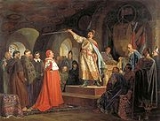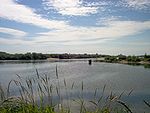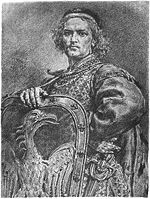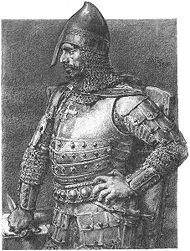
Battle of Zawichost
Encyclopedia
The Battle of Zawichost (1205) was a skirmish fought between Roman the Great
of Galicia-Volhynia and Leszek I the White
of Lesser Poland
, along with his brother, Konrad I of Masovia
. After declaring war and invading Lesser Poland, Roman and his forces (druzhina
) were ambushed by the Poles in the vicinity of Zawichost
by the Vistula
(Visla) River. In the tumult that followed, Roman was killed and the Polish victory would lead to Poland's growing power and the weakening of Rus'.
 In the 11th century, Poland and Rus' entered a border dispute and the lands of Lesser Poland
In the 11th century, Poland and Rus' entered a border dispute and the lands of Lesser Poland
and Rus' (called Ruthenia in Latin) were changing hands constantly. In the early Middle Ages
, the area of what later would become Galicia was scarcely populated, as the region was settled by Rus' peoples from the east and by Poles from the west. Border-clashes took place in the lands of Przemyśl
, Sanok
, Drohiczyn
and Vladimir-in-Volhynia
. The decline of Kievan Rus'
gave Poland the opportunity to seize control of the regions. In 1199, an armed campaign led by Leszek the White helped to install Roman the Great
on the throne in Vladimir-in-Volhynia. In 1205, however, Roman declares war on Poland. The Polish chronicle, Jan Długosz, tried to give reasons for Roman's declaration of war:
Długosz further explains that before crossing the Polish frontier, Roman sent emissaries to the Bishop of Vladimir and asked for his blessing, as he intended to campaign in Poland for three years. The Bishop declined Roman's gifts and denied him any blessing, explaining that "he cannot bless Roman or his enterprise, since he has previously started unjust and wicked wars and is again embarking on one that is quite unjustified, considering that the Poles have so often exposed their bodies to danger and death to defend the Ruthenians against the barbarians." Roman responded by telling the bishop that he will cut his head off when he returns from his victory.
 In the early spring, Roman invaded the land of Lublin
In the early spring, Roman invaded the land of Lublin
and laid siege to the city. The Polish garrison was successful in defending the city, but the Rus'ian caused great destruction to the local population, as they captured and raped the wives of the knights of Lublin. Leszek then started recruiting a force of knights and peasants from Sandomierz
, Kujawy, and Mazovia
, which ws reinforced with a force of volunteers from Kraków
. When Roman learned of the Polish force that was advancing towards him, he raised the siege and advanced deep into Poland by pillaging and threatening with devastation and eradication of the Latin rite. Several bishops and nobles approach Roman and asked for peace, promising to pay compensation; Roman accepted, but continued with the war. He captured some priests and had them shot at with arrows, hoping to disclose the location of Leszek. Długosz gives a detailed description of the battle:

 Other accounts mention the same turn of events. The Suzdal Chronicle of the Laurentian Codex
Other accounts mention the same turn of events. The Suzdal Chronicle of the Laurentian Codex
) mentions that "Roman of Halych took on Poles and conquered cities. And stopped at the Vistula River with his small druzhina. Poles then attacked and killed him with the druzhina. And people from Halych came, took their dead prince and carried him to Halych and buried him in a church." According to the later "Chronica Poloniae Maioris") Roman "refuses to pay the tribute to Leszek, bravely challenges him and with amassing the large force unexpectedly invades into the Polish lands. As Leszek found that out, he assembled a small troop rushed to meet him in Zawichost, fiercely attacks him, captures and defeats. Of the Ruthenians, that initially came arrogantly, many were wounded, very many killed with prince Roman, and the others, seeing [that] tried to find the rescue escaping, and many pathetically ended their lives in the Vistula [...] And so happened in 1205 AD."kh sosediakh, XI-XIII vv.] (The Great Chronicle of Poland, Rus' and their negbours).
Many of the Rus' drowned and many more died at the hands of the local population, as Polish troops chased them all the way to Vladimir
. Few survived the massacre and at the order of Leszek and Konrad, Roman's body was buried in Sandomierz
. The two factions came to an agreement and the Russians released all their prisoners and paid 1,000 silver marks to recover the body of Roman, which was then buried in Vladimir.
 After his triumph, Leslek's reputation took a positive turn, earning him credibility and the trust of Kraków, which would give him temporary power over the city. Konrad, coming of age, asks for his share of power and at the meditation of their mother and a selected group of aristocrats, the two brothers divide the country under their authority. Rus' turned unstable from its internal conflicts and the country is invaded by Lithuanians
After his triumph, Leslek's reputation took a positive turn, earning him credibility and the trust of Kraków, which would give him temporary power over the city. Konrad, coming of age, asks for his share of power and at the meditation of their mother and a selected group of aristocrats, the two brothers divide the country under their authority. Rus' turned unstable from its internal conflicts and the country is invaded by Lithuanians
, this being the first time the Poles hear of that name. The Ruthenians suffered great casualties, but managed to defeat the invaders. In 1208, the country falls in civilwar.
Roman the Great
Roman Mstislavich , also Roman Mstyslavych or Roman the Great, was a Rus’ prince, Grand Prince of Kiev ....
of Galicia-Volhynia and Leszek I the White
Leszek I the White
Leszek I the White , also listed by some sources as Leszek II the White, was Prince of Sandomierz and High Duke of Poland from 1194 until his death, except for the short periods following when he was deposed as Polish ruler...
of Lesser Poland
Lesser Poland
Lesser Poland is one of the historical regions of Poland, with its capital in the city of Kraków. It forms the southeastern corner of the country, and should not be confused with the modern Lesser Poland Voivodeship, which covers only a small, southern part of Lesser Poland...
, along with his brother, Konrad I of Masovia
Konrad I of Masovia
Konrad I of Masovia , from the Polish Piast dynasty, was the sixth Duke of Masovia from 1194 until his death and High Duke of Poland from 1229 to 1232.-Life:...
. After declaring war and invading Lesser Poland, Roman and his forces (druzhina
Druzhina
Druzhina, Drużyna or Družyna in the medieval history of Slavic Europe was a retinue in service of a chieftain, also called knyaz. The name is derived from the Slavic word drug with the meaning of "companion, friend". -Early Rus:...
) were ambushed by the Poles in the vicinity of Zawichost
Zawichost
Zawichost is a small town in Sandomierz County, Świętokrzyskie Voivodeship, Poland. It is located by the Vistula River in southern Poland, near Sandomierz....
by the Vistula
Vistula
The Vistula is the longest and the most important river in Poland, at 1,047 km in length. The watershed area of the Vistula is , of which lies within Poland ....
(Visla) River. In the tumult that followed, Roman was killed and the Polish victory would lead to Poland's growing power and the weakening of Rus'.
Background

Lesser Poland
Lesser Poland is one of the historical regions of Poland, with its capital in the city of Kraków. It forms the southeastern corner of the country, and should not be confused with the modern Lesser Poland Voivodeship, which covers only a small, southern part of Lesser Poland...
and Rus' (called Ruthenia in Latin) were changing hands constantly. In the early Middle Ages
Middle Ages
The Middle Ages is a periodization of European history from the 5th century to the 15th century. The Middle Ages follows the fall of the Western Roman Empire in 476 and precedes the Early Modern Era. It is the middle period of a three-period division of Western history: Classic, Medieval and Modern...
, the area of what later would become Galicia was scarcely populated, as the region was settled by Rus' peoples from the east and by Poles from the west. Border-clashes took place in the lands of Przemyśl
Przemysl
Przemyśl is a city in south-eastern Poland with 66,756 inhabitants, as of June 2009. In 1999, it became part of the Podkarpackie Voivodeship; it was previously the capital of Przemyśl Voivodeship....
, Sanok
Sanok
Sanok is a town in south-eastern Poland with 39,110 inhabitants, as of 2 June 2009. It's the capital of Sanok County in the Subcarpathian Voivodeship. Previously, it was in the Krosno Voivodeship and in the Ruthenian Voivodeship , which was part of the Lesser Poland province...
, Drohiczyn
Drohiczyn
Drohiczyn is a small historic town in Siemiatycze County, Podlaskie Voivodeship, Poland. The town with population 2,110 is situated on a bank of the Bug River.- History :...
and Vladimir-in-Volhynia
Volodymyr-Volynskyi
Volodymyr-Volynsky is a city located in Volyn Oblast, in north-western Ukraine. Serving as the administrative centre of the Volodymyr-Volynsky District, the city itself is also designated as a separate raion within the oblast...
. The decline of Kievan Rus'
Kievan Rus'
Kievan Rus was a medieval polity in Eastern Europe, from the late 9th to the mid 13th century, when it disintegrated under the pressure of the Mongol invasion of 1237–1240....
gave Poland the opportunity to seize control of the regions. In 1199, an armed campaign led by Leszek the White helped to install Roman the Great
Roman the Great
Roman Mstislavich , also Roman Mstyslavych or Roman the Great, was a Rus’ prince, Grand Prince of Kiev ....
on the throne in Vladimir-in-Volhynia. In 1205, however, Roman declares war on Poland. The Polish chronicle, Jan Długosz, tried to give reasons for Roman's declaration of war:
Długosz further explains that before crossing the Polish frontier, Roman sent emissaries to the Bishop of Vladimir and asked for his blessing, as he intended to campaign in Poland for three years. The Bishop declined Roman's gifts and denied him any blessing, explaining that "he cannot bless Roman or his enterprise, since he has previously started unjust and wicked wars and is again embarking on one that is quite unjustified, considering that the Poles have so often exposed their bodies to danger and death to defend the Ruthenians against the barbarians." Roman responded by telling the bishop that he will cut his head off when he returns from his victory.
Battle

Lublin
Lublin is the ninth largest city in Poland. It is the capital of Lublin Voivodeship with a population of 350,392 . Lublin is also the largest Polish city east of the Vistula river...
and laid siege to the city. The Polish garrison was successful in defending the city, but the Rus'ian caused great destruction to the local population, as they captured and raped the wives of the knights of Lublin. Leszek then started recruiting a force of knights and peasants from Sandomierz
Sandomierz
Sandomierz is a city in south-eastern Poland with 25,714 inhabitants . Situated in the Świętokrzyskie Voivodeship , previously in Tarnobrzeg Voivodeship . It is the capital of Sandomierz County . Sandomierz is known for its Old Town, a major tourist attraction...
, Kujawy, and Mazovia
Mazovia
Mazovia or Masovia is a geographical, historical and cultural region in east-central Poland. It is also a voivodeship in Poland.Its historic capital is Płock, which was the medieval residence of first Dukes of Masovia...
, which ws reinforced with a force of volunteers from Kraków
Kraków
Kraków also Krakow, or Cracow , is the second largest and one of the oldest cities in Poland. Situated on the Vistula River in the Lesser Poland region, the city dates back to the 7th century. Kraków has traditionally been one of the leading centres of Polish academic, cultural, and artistic life...
. When Roman learned of the Polish force that was advancing towards him, he raised the siege and advanced deep into Poland by pillaging and threatening with devastation and eradication of the Latin rite. Several bishops and nobles approach Roman and asked for peace, promising to pay compensation; Roman accepted, but continued with the war. He captured some priests and had them shot at with arrows, hoping to disclose the location of Leszek. Długosz gives a detailed description of the battle:


Laurentian Codex
Laurentian Codex or Laurentian Chronicle is a collection of chronicles that includes the oldest extant version of the Primary Chronicle and its continuations, mostly relating the events in Northern Russia ....
) mentions that "Roman of Halych took on Poles and conquered cities. And stopped at the Vistula River with his small druzhina. Poles then attacked and killed him with the druzhina. And people from Halych came, took their dead prince and carried him to Halych and buried him in a church." According to the later "Chronica Poloniae Maioris") Roman "refuses to pay the tribute to Leszek, bravely challenges him and with amassing the large force unexpectedly invades into the Polish lands. As Leszek found that out, he assembled a small troop rushed to meet him in Zawichost, fiercely attacks him, captures and defeats. Of the Ruthenians, that initially came arrogantly, many were wounded, very many killed with prince Roman, and the others, seeing [that] tried to find the rescue escaping, and many pathetically ended their lives in the Vistula [...] And so happened in 1205 AD."kh sosediakh, XI-XIII vv.] (The Great Chronicle of Poland, Rus' and their negbours).
Many of the Rus' drowned and many more died at the hands of the local population, as Polish troops chased them all the way to Vladimir
Vladimir
Vladimir is a city and the administrative center of Vladimir Oblast, Russia, located on the Klyazma River, to the east of Moscow along the M7 motorway. Population:...
. Few survived the massacre and at the order of Leszek and Konrad, Roman's body was buried in Sandomierz
Sandomierz
Sandomierz is a city in south-eastern Poland with 25,714 inhabitants . Situated in the Świętokrzyskie Voivodeship , previously in Tarnobrzeg Voivodeship . It is the capital of Sandomierz County . Sandomierz is known for its Old Town, a major tourist attraction...
. The two factions came to an agreement and the Russians released all their prisoners and paid 1,000 silver marks to recover the body of Roman, which was then buried in Vladimir.
Aftermath

Lithuanians
Lithuanians are the Baltic ethnic group native to Lithuania, where they number around 2,765,600 people. Another million or more make up the Lithuanian diaspora, largely found in countries such as the United States, Brazil, Canada, Colombia, Russia, United Kingdom and Ireland. Their native language...
, this being the first time the Poles hear of that name. The Ruthenians suffered great casualties, but managed to defeat the invaders. In 1208, the country falls in civilwar.

